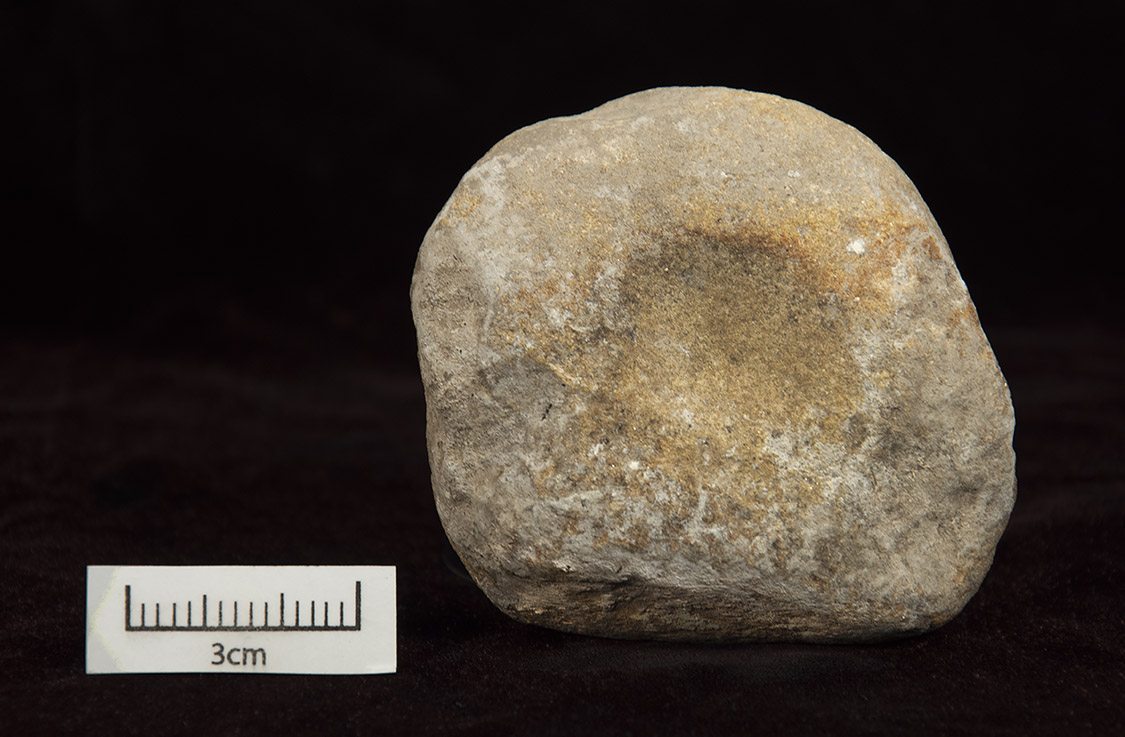
Emily L. Beahm, Arkansas Archeological Survey, Winthrop Rockefeller Institute Station
Artifact of the Month - August 2019
In October of 1986, the Arkansas Archeological Survey, with help from several members of the Arkansas Archeological Society, held a small-scale excavation at Rockhouse Cave (Sabo 1987). The goal of this testing was to evaluate the archeological deposits in this large bluff shelter in order to assist Petit Jean State Park to protect and preserve the site. On October 11th, Scott Akridge, Glen Akridge, and Danny Moore, members of the Arkansas Archeological Society, were excavating in the center area of the shelter. A living floor was identified in this location at about 16 centimeters below the present-day ground surface. “Living floor” is a term archeologists use to identify an excavated surface that was once the actual ground surface walked and “lived on” by the people who inhabited a site. On this living floor the pitted stone pictured here was recorded and excavated, along with a piece of pottery, a projectile point, and a burnt nut shell (Figure 1).
This pitted stone is made out of sandstone and has a U-shaped pit on two opposite sides. It measures 7.8 cm long, 7.5 cm wide, and 4.4 cm thick, and weighs 326.7 grams. The pits on the stone are about 2.9 cm in diameter and 3 mm deep (Figure 2). This type of artifact is commonly called a “pitted stone” or a “nutting stone” by archeologists (Hilliard 1980; House 1975; Spears 1975). These types of artifacts are most commonly interpreted as anvils used as the base for cracking open nuts. The process of hitting many hard nuts on relatively soft sandstone will create a smooth, cup-like indentation in the anvil, which in turn would help prevent the nuts from rolling around while being cracked.
This interpretation of pitted stones was tested in 1975 by Carol Spears. She conducted an experiment to determine whether cracking open nuts would form this type of pit on sandstone. She determined that “The use of a sandstone cobble as a hammerstone to crack nuts on a sandstone anvil will produce shallow U-shaped pits on both the hammer and anvil. Thus sandstone cobbles with shallow U-shaped pits may have been formed by nut cracking activities” (Spears 1975:104). It was also determined that similar U-shaped pits can be formed during the process of cracking open smooth chert cobbles in the beginning stage of stone-tool manufacture, although subsequent cracking of irregular rocks will create V-shaped pits. In the case of the Rockhouse Cave pitted stone, the use as an anvil for cracking open nuts seems most likely.

Nutting stones are not temporally diagnostic. That is, nuts were gathered, processed, and eaten throughout the pre-contact and into post-European contact times in Arkansas (House 1975:72). Nuts have been important dietary components since at least the Middle Archaic period (ca. 5,000–8,000 years ago) in the southeastern and midwestern United States and are commonly found in paleoethnobotanical samples that date throughout this time (Moore and Dekle 2010).
Early European observers of Native Americans mention being served nuts raw, boiled, in the form of bread, or as oil by the people they encountered (Gardner 1997:161). For example, according to Ranjel's account of Hernando de Soto’s expedition of 1539–1543: “…they were also given an abundance of corn cakes, and no end of oil from walnuts and acorns, which they knew how to extract very well, which was very good and contributed much to their diet” (Ranjel 1904:107–108).
There is also ethnohistorical evidence for the use of stones in nut processing: “There are two kinds of walnuts [black walnuts and hickories] and of the inifinit store…Besides eating of them after our ordinaire manner, they breake them with stones and pound them into mortars with water to make milk…” (Hariot 1588:25).
Native Americans collected a number of kinds of nuts to eat including acorns, hickory, pecans, walnuts, and chestnuts (Abrams and Nowacki 2008). Nuts, particularly hickory nuts, were an especially valuable food resource for at least a couple reasons. First, they are a great source of nutrition including fat and amino acids (Gardner 1997:162). Second, they are easily stored. While nuts become ripe and need to be gathered relatively quickly to prevent other animals from making off with them, once nuts have been gathered, all that is necessary to prepare them for long term storage is to parch them, that is, heat them in order to prevent mold or insects from spoiling the nuts (Gardner 1997:174; Hilliard 1980:16). Stored nuts provided an important food source during the winter and early spring when other sources of food were limited.
Because we have a detailed record of exactly where this nutting stone was found and what artifacts were found with it, we can draw some conclusions about when it was used. This pitted stone was found in Feature 3, on top of a living surface at Rockhouse Cave, along with a shell-tempered pottery sherd and a Lantry type projectile point. We can use dates associated with these temporally diagnostic artifacts to infer when the pitted stone was used and deposited. Shell-tempered pottery appears relatively early in parts of Arkansas by the Late Woodland period (ca. A.D. 600–900) and continues to be used in the Mississippi period (A.D. 900–1500) (Sabo and Hilliard 2008). Lantry type projectile points were made and used beginning in the Archaic period and up to about A.D. 700–800 (Bell and Perino 1958:38; Suhm and Jeckles 1962:205). Therefore, it is estimated that this nutting stone was used to process nuts at Rockhouse cave around A.D. 700 to 800.
This pitted stone provides information about what people were eating and the specific activities that people were engaged in at Rockhouse Cave. While the rock art at Rockhouse Cave is certainly spectacular, Native Americans used the shelter for other purposes as well. This pitted stone tells us that one of those other activities was processing gathered nuts. It is likely that Rockhouse Cave, located as it is in an environment rich with nut trees, would be an ideal location for gathering and processing nuts.
Materials: sandstone
Dimensions: 78.30mm x 74.89mm x 44.27mm
Age Estimate: A.D. 700 to A.D.800
Courtesy of the Arkansas Archeological Survey
For more information about Rockhouse Cave:
https://archeology.uark.edu/ozarkbluffshelters/learn-more/visit-a-shelter/rock-house-cave-at-petit-jean-state-park/
For more information on the 1986 excavations at Rockhouse Cave:
https://archeology.uark.edu/rockart/index.html?pageName=Excavations%20at%20Rockhouse%20Cave
For more information about visiting Rockhouse Cave:
https://www.arkansasstateparks.com/parks/petit-jean-state-park
Works Cited
Abrams, Marc D., and Gregory J. Nowacki
2008 Native Americans as Active and Passive Promoters of Mast and Fruit Trees in the Eastern USA. The Holocene 18(7):1123–1137.
Bell, Robert Eugene, and Gregory Perino
1958 Guide to the Identification of Certain American Indian Projectile Points. Vol. 1. Oklahoma Anthropological Society.
Gardner, Paul S.
1997 Chapter 8: The Ecological Structure and Behavioral Implications of Mast Exploitation Strategies. In People, Plants, and Landscapes: Studies in Paleoethnobotany, edited by Kristen J. Gremillion, pp. 161–178. University of Alabama Press.
Hariot, Thomas
1588 A Brief and True Report of the New Found Land of Virginia. Electronic Texts in American Studies, edited by Paul Royster (2007):20.
Hilliard, Jerry Edward
1980 Prehistoric Ozark Settlement – Subsistence and Nut Resource Utilization. Unpublished Master’s Thesis, University of Arkansas, Department of Anthropology. 71 pages.
House, John H.
1975 A Functional Typology for Cache Project Surface Collections. In The Cache River Archeological Project: An Experiment in Contract Archeology, assembled by Michael B. Schiffer and John H. House. Research Series No. 8. Arkansas Archeological Survey, Fayetteville.
Moore, Christopher R., and Victoria G. Dekle
2010 Hickory Nuts, Bulk Processing and the Advent of Early Horticulture Economies in Eastern North America. World Archaeology 42(4):595–608.
Peres, Tanya M.
2017 Foodways Archaeology: A Decade of Research from the Southeastern United States. Journal of Archaeological Research 25(4):421–460.
Ranjel, Rodrigo
1904 A Narrative of de Soto's Expedition based on the Diary of Rodrigo Ranjel, his private Secretary, by Gonzalo Fernandez de Oviedo y Valdes. In Narratives of the Career of Hernando de Soto," edited by E. G. Bourne.
Sabo, George III
1987 Gimme Shelter: Test Excavations at Rockhouse Cave (3CN20) in Petit Jean State Park. Field Notes: Newsletter of the Arkansas Archeological Society 214:8–12.
Sabo, George III, and Jerry E. Hilliard
2008 Woodland Period Shell-Tempered Pottery in the Central Arkansas Ozarks. Southeastern Archaeology 27(2):164–171.
Spears, Carol S.
1975 Chapter 11: Hammers, Nuts, and Jolts, Cobbles, Cobbles, Cobbles: Experiments in Cobble Technologies in Search of Correlates. In Arkansas Eastman Project by Charles Baker. Arkansas Archeological Survey Research Report No. 6, pp. 83–116.
Suhm, Dee Ann, and Edward B. Jelks
1952 Handbook of Texas Archaeology: Type Descriptions. Texas Memorial Museum, The University of Texas at Austin.
 Collections and items in our institution have incomplete, inaccurate, and/or missing attribution. We are using this notice to clearly identify this material so that it can be updated, or corrected by communities of origin. Our institution is committed to collaboration and partnerships to address this problem of incorrect or missing attribution. For more information, visit localcontexts.org.
Collections and items in our institution have incomplete, inaccurate, and/or missing attribution. We are using this notice to clearly identify this material so that it can be updated, or corrected by communities of origin. Our institution is committed to collaboration and partnerships to address this problem of incorrect or missing attribution. For more information, visit localcontexts.org.
 The Arkansas Archeological Survey is committed to the development of new modes of collaboration, engagement, and partnership with Indigenous peoples for the care and stewardship of past and future heritage collections.
The Arkansas Archeological Survey is committed to the development of new modes of collaboration, engagement, and partnership with Indigenous peoples for the care and stewardship of past and future heritage collections.
 The TK Notice is a visible notification that there are accompanying cultural rights and responsibilities that need further attention for any future sharing and use of this material. The TK Notice may indicate that TK Labels are in development and their implementation is being negotiated. For more information about the TK Notice, visit localcontexts.org.
The TK Notice is a visible notification that there are accompanying cultural rights and responsibilities that need further attention for any future sharing and use of this material. The TK Notice may indicate that TK Labels are in development and their implementation is being negotiated. For more information about the TK Notice, visit localcontexts.org.
